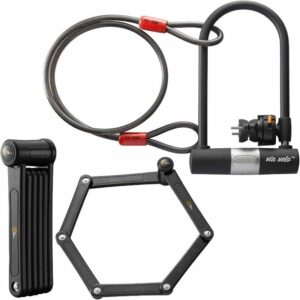Electric Bike Safety – Everything E-Bikers Should Know About Safety
Key Takeaways
- Pre-Ride Checks: Ensuring your e-bike is in good condition before each ride is crucial. Check brakes, tires, and battery charge.
- Visibility Matters: Use reflective gear and lights to make yourself visible to others, especially during dawn, dusk, and nighttime.
- Follow Traffic Rules: Adhere to local traffic laws and cycling regulations to prevent accidents and ensure safe cohabitation with vehicles and pedestrians.
- Wear Safety Gear: Helmets, gloves, and protective clothing are essential for reducing injury risk.
- Understand Your E-Bike: Familiarize yourself with the e-bike’s features and controls, particularly if you’re a new rider.
- Stay Alert: Keep an eye on your surroundings and anticipate the actions of other road users.
- Ride According to Conditions: Adjust your speed and riding style to match the weather and road conditions.
- Battery and Motor Care: Proper maintenance of the battery and motor enhances performance and safety.
- Emergency Preparedness: Know how to handle common emergencies and mechanical issues.
- Educate Yourself: Continually learn about e-bike safety, maintenance, and riding techniques.
Safeguarding Your Ride: Navigating the World of E-Bike Safety
With the rise of electric bikes as a popular mode of urban and recreational transportation, understanding and implementing e-bike safety practices have never been more crucial. These innovative machines blend the classic cycling experience with the added zest of electric power, bringing forth new dynamics to the age-old cycling lore. However, with great power comes the increased responsibility of ensuring one’s safety and the well-being of those who share our paths.
The essence of electric bike safety transcends mere adherence to traffic laws; it’s about cultivating a mindset that prioritizes precaution and respect for all road users. From the essential pre-ride checks that keep technical mishaps at bay to the subtle art of navigating traffic, each aspect of e-bike safety is a thread in the larger fabric of responsible riding. Moreover, as e-bikes carve their niche in the transportation landscape, riders are called upon to be ambassadors of safe cycling, showcasing how these electric marvels can coexist harmoniously with traditional bicycles, pedestrians, and motor vehicles alike.
This article delves into the multifaceted world of e-bike safety, offering insights, tips, and practical advice to empower riders with the knowledge they need to enjoy their journeys while minimizing risks. Whether you’re a seasoned e-bike enthusiast or a newcomer eager to explore, understanding the nuances of safe e-bike riding is an invaluable part of your cycling journey. Let’s embark on this ride together, equipped with the wisdom to navigate the exhilarating yet challenging terrain of e-bike safety.
Harnessing the Power: Understanding E-Bike Mechanics for a Safe Ride
Electric bikes, blending traditional cycling with electric power, bring a new dimension to bike safety. Understanding your e-bike’s unique features, particularly motor power and speed, is crucial for safe operation. E-bikes come in various classifications, each with differing speed limits and power outputs, directly influencing how they should be handled in different riding conditions.
Familiarizing yourself with your e-bike goes beyond knowing how to turn it on and off. It involves understanding how its motor reacts under different loads, the responsiveness of its electric-assist levels, and how these functions interact with your riding style. For instance, higher-powered motors can accelerate more quickly, necessitating a rider’s adeptness in controlling speed to avoid accidents.
 Moreover, the ability to manage the bike’s speed capably is essential, as e-bikes can easily surpass the speeds of traditional bicycles, especially on flat terrains or uphill climbs. This capability requires riders to have a heightened awareness of their surroundings, foreseeing potential hazards and reacting accordingly.
Moreover, the ability to manage the bike’s speed capably is essential, as e-bikes can easily surpass the speeds of traditional bicycles, especially on flat terrains or uphill climbs. This capability requires riders to have a heightened awareness of their surroundings, foreseeing potential hazards and reacting accordingly.
Equally important is the knowledge of your e-bike’s braking system. Electric bikes are generally heavier than their non-electric counterparts, which can affect stopping distances. Being acquainted with how your e-bike handles in emergency stops or during regular deceleration is vital for preventing collisions.
In essence, the journey to mastering e-bike safety starts with a thorough understanding of its functionalities. By taking the time to learn about your e-bike’s features and how they influence its operation, you’re not only enhancing your safety but also ensuring a more enjoyable and confident riding experience. This section serves as a foundation for the comprehensive exploration of safety practices covered in the remainder of this guide, aimed at empowering riders with the knowledge to navigate the electric biking experience safely and responsibly.
Gear Up: The Critical Safety Role of Personal Protective Equipment and E-Bikes
Navigating the world on two wheels with the added power of an electric motor makes wearing the right protective gear not just advisable but essential. Emphasizing the non-negotiable nature of personal protective equipment (PPE) for e-bikers is crucial. By gearing up with the appropriate helmet, gloves, shoes, and reflective wear, riders can significantly mitigate their risk of injury and enhance their visibility on the road, making every journey safer and more secure.
Helmet: Your Best Defense
The helmet is the cornerstone of your safety attire. Opt for models specifically designed for cycling, ensuring they meet safety standards such as ASTM, CPSC, or EN 1078. To prevent head injury, a proper fit is crucial: it should sit snugly on your head without being overly tight, with straps properly adjusted to keep it in place during a ride.
Hands-On: The Importance of Gloves
Gloves serve a dual purpose: protecting your hands in case of a fall and improving grip for better control. Full-fingered gloves are recommended for e-biking, offering protection against scrapes and weather, while also cushioning your hands from vibrations.
Footwear: Firm Footing Ahead
Sturdy shoes with a good grip can significantly enhance your control over the e-bike. They protect your feet and ensure efficient power transfer to the pedals, making your ride safer and more comfortable.
Visibility: Be Seen, Be Safe
Reflective clothing and accessories play a vital role, especially during dawn, dusk, or nighttime riding. High-visibility vests, reflective bands, and even clothing with integrated LED lights can make you more conspicuous to drivers, other cyclists, and pedestrians.
Essential Steps for a Safe Ride: Pre and Post-Ride Electric Bike Checks
Embarking on an e-bike ride involves more than just pedaling away; it requires a thorough check to ensure your ride is as safe as it is enjoyable. Let’s delve into the essential pre-ride and post-ride safety checks that every e-biker should perform.
Pre-Ride Checks
Battery Charge and Connection: Ensure your e-bike’s battery is fully charged and securely connected. A well-charged battery guarantees not only a longer ride but also consistent performance of all electronic components.

Tire Pressure: Checking tire pressure is crucial for optimal riding conditions. Properly inflated tires reduce the risk of punctures and provide a smoother ride.
Brake Functionality: Test your brakes before setting off. Effective brakes are your best defense against unforeseen obstacles.
Lights and Reflectors: Verify that all lights and reflectors are functioning and securely attached, enhancing your visibility to others.
Post-Ride Checks
Inspect for Wear and Tear: After your ride, inspect your bike for any signs of wear or damage, especially to the tires, frame, and brake pads.
Clean and Store Properly: A quick clean can remove debris that might affect your bike’s performance. Store your e-bike in a safe, dry place to protect it from the elements.
By incorporating these checks into your riding routine, you can ensure that each journey on your e-bike is safe and enjoyable. Remember, a few minutes of preparation can prevent many common issues encountered on the road.
Mastering Safe E-Bike Riding: Techniques and Considerations
Riding an e-bike safely is an art that combines knowledge, skill, and situational awareness. This section delves into the practices that ensure a safe and enjoyable ride, emphasizing speed control, signaling, weather considerations, and navigating the challenges of night riding.
Speed Control and Signaling
Speed Management: Understanding and controlling your e-bike’s speed is fundamental. Always adjust your speed according to the environment, traffic conditions, and local speed limits to maintain control and reduce the risk of accidents.
Clear Signaling: Use hand signals to communicate your intentions to other road users. Signaling turns and stops in advance promotes safety and predictability, essential elements on busy streets.
Adapting to Weather Conditions
Weather Readiness: Different weather conditions demand specific riding strategies. In wet conditions, reduce your speed, and increase your stopping distance. On windy days, be cautious of gusts that could affect your balance.
Equipment Checks: Ensure your e-bike’s tires and brakes are suited for the weather you’ll be riding in. Consider using tires with better grip for rainy days to prevent slipping.
Night Riding
Illuminate Your Path: Effective lighting is crucial for night riding. Use a strong front light to illuminate your path and a red rear light to make yourself visible to following traffic.

Reflective Gear: Wear reflective clothing and accessories to enhance your visibility to other road users. Reflective tape can also be added to your e-bike and helmet for extra visibility.
Stay Alert: At night, your visibility and that of other road users are diminished. Stay extra vigilant, and be prepared for the unexpected.
By adopting these practices, e-bike riders can significantly enhance their safety, regardless of the time of day or weather conditions. Each ride is an opportunity to practice and perfect these techniques, contributing to a safer cycling environment for everyone.
Harmonious Pathways: Sharing the Road with Everyone
Expanding on the importance of safe interaction on the road, e-bike riders must practice awareness and respect towards all road users. This means understanding the dynamics of mixed traffic environments and adopting behaviors that promote safety and harmony.
For instance, when encountering cars, make sure to maintain a visible position in the lane, avoid blind spots, and signal intentions well in advance. This clarity helps prevent accidents caused by sudden movements. Similarly, when

navigating areas crowded with pedestrians, reducing speed significantly, alerting them of your presence with a gentle bell ring, and always giving them the right of way.
Interactions with fellow cyclists also require courtesy and communication. Use hand signals not just for turns and stops, but also to indicate hazards on the road to those behind you. When overtaking another cyclist, do so on the left, signaling your intention, and allow ample space to avoid startling them.
Providing real-world examples, such as a scenario where an e-bike rider carefully overtakes a slower cyclist on a shared bike path, can illustrate the right approach. The rider checks the path ahead is clear, signals intention to overtake, passes safely leaving enough room, and then merges back with a thank you gesture. Such actions not only ensure safety but also foster a positive atmosphere among road users.
Adopting these respectful and aware practices ensures a safer and more enjoyable experience for everyone on the road, reinforcing the e-bike community’s commitment to harmonious coexistence with all types of commuters.
Cycling with Confidence: The Cornerstone of Maintenance and Care
The journey of an e-bike rider is punctuated by the rhythmic cadence of regular maintenance and care. This commitment not only ensures your ride remains in peak condition but also ties back to the crucial pre and post-ride checks highlighted earlier. Regular maintenance tasks, such as lubricating the chain, checking for wear and tear on the brake pads, and ensuring all electrical connections are secure, form the backbone of a safe cycling experience.

For example, a well-lubricated chain reduces the risk of sudden breaks or malfunctions, which could lead to accidents, especially at higher speeds. Similarly, timely replacement of worn-out brake pads is essential for effective stopping power, directly impacting your safety on the road.
Incorporating pre and post-ride checks into your regular maintenance routine significantly enhances your e-bike’s safety and longevity. These checks, acting as a first line of defense, can help identify potential issues early on, such as loose bolts, tire wear, or battery degradation, preventing them from escalating into more significant problems. By integrating these inspections with routine maintenance tasks like chain lubrication, brake pad replacement, and software updates, you ensure a comprehensive approach to e-bike care. This proactive strategy minimizes unexpected breakdowns and maintains optimal performance, ensuring each ride is both safe and enjoyable.
Innovating for a Safer Ride: The Intersection of Technology and E-Bike Safety
As electric bikes evolve, integrating advanced technology becomes crucial in enhancing rider safety. These innovations not only make rides more enjoyable but significantly reduce the risks associated with e-biking.
Advanced Braking Systems
ABS (Anti-lock Braking System): A paramount safety feature in vehicles, ABS is making its way into e-bikes. By preventing the wheels from locking up during sudden braking, ABS ensures the rider maintains control and stability, particularly on slippery surfaces. This technology is vital in avoiding accidents, as it allows for safer, more controlled stops.
Smart Lighting
Automatic Lights and Turn Signals: E-bikes are increasingly equipped with intelligent lighting systems that adjust to the riding environment. Automatic headlights that turn on in low light conditions, and integrated turn signals, enhance visibility and communication with other road users. These features are invaluable during night rides or in adverse weather conditions.
Electronic Control Systems
Traction Control and Power Assist Management: Modern e-bikes include systems that manage power delivery efficiently, ensuring smooth acceleration and preventing wheel slip. Traction control systems detect and adjust for loss of grip, while power assist management tailors the motor’s output to the riding conditions, offering a safer and more responsive riding experience.
Connectivity and Diagnostics
Smartphone Integration and Health Monitoring: Many e-bikes now offer connectivity options, allowing riders to monitor their bike’s health and performance through smartphone apps. These apps can provide diagnostics and maintenance reminders, and even alert riders to potential safety issues before they become problematic.
Monitoring: Many e-bikes now offer connectivity options, allowing riders to monitor their bike’s health and performance through smartphone apps. These apps can provide diagnostics and maintenance reminders, and even alert riders to potential safety issues before they become problematic.
By embracing these technological advancements, e-bike manufacturers not only improve the riding experience but also set new standards for safety in the cycling industry. As technology continues to evolve, the potential for even safer, more intuitive e-biking experiences becomes a promising horizon for riders worldwide.
Navigating Through the Unexpected: Electric Bikes and Emergency Preparedness
Being prepared for emergencies, whether they are accidents or mechanical failures, is crucial for every e-bike rider. Here’s how to handle these situations with confidence and safety.
In Case of an Accident
Stay Calm and Assess the Situation: Your priority is to ensure your safety and that of others involved. Move to a safe location if you’re able, and check for injuries.
Call for Help: If there are any injuries or significant damage, call emergency services immediately. Even minor accidents can have delayed health effects.
Exchange Information: If the accident involves another party, exchange contact and insurance information.
Handling Mechanical Failures
Know Your E-Bike: Familiarize yourself with your e-bike’s basic troubleshooting. Understanding error codes or recognizing common issues can help you address problems on the go.
Carry a Repair Kit: Always have a basic e-bike repair kit and know how to use it. This should include tools for tire changes, a multi-tool for adjustments, and spare tubes or a patch kit.
Safe Pull-Over Practices: If your e-bike fails while riding, signal to others and move to a safe location off the road to assess and attempt a repair.
Practice Makes Perfect
Simulated Emergency Drills: In a controlled environment, practice handling potential emergencies. This can include practicing sudden stops for mechanical failures or learning the best ways to fall to minimize injury.
First Aid Training: Knowing basic first aid can be invaluable in an emergency. Consider taking a course to be better prepared for any injuries that may occur.
Being prepared for emergencies involves both knowing how to react in the moment and having the foresight to prevent incidents through regular maintenance and care. By equipping yourself with knowledge, tools, and practice, you can ensure a safer riding experience on your e-bike.
FAQs and E-Bike Safety Tips
- What are the essential safety checks before riding an e-bike? Before riding, ensure your e-bike’s brakes are functioning properly, the tires are inflated to the recommended pressure, the battery is adequately charged, and all lights are working.
- How do I choose the right helmet for e-biking? Select a helmet that meets safety standards, fits snugly but comfortably, and is specifically designed for cycling. Look for additional features like MIPS for rotational impact protection.
- What are the key differences in riding an e-bike compared to a traditional bike? E-bikes have a motor that provides pedal assistance, which means you can achieve higher speeds with less effort. This requires heightened awareness and quicker reactions to navigate safely.
- How can I ensure visibility to other road users while riding my e-bike? Use front and rear lights, and reflective clothing, and signal your turns. Consider adding a bell or horn to alert others when necessary.
- What should I do if my e-bike starts malfunctioning while I’m riding? Slow down safely, pull over to a secure location, and assess the issue. If it’s a minor problem, you may be able to fix it. Otherwise, seek professional help.
- Are there specific traffic rules for e-bikes? Yes, e-bike riders must follow the same traffic laws as traditional cyclists, with additional regulations that may apply based on local laws, such as speed limits and helmet usage.
- How can I safely ride my e-bike in wet or slippery conditions? Reduce speed, increase stopping distance, use lights, and avoid sudden turns or movements. Ensure your tires are suitable for wet conditions.
- What maintenance routines should I follow to keep my e-bike safe? Regularly check and maintain your brakes, tires, battery, and electrical connections. Follow the manufacturer’s guidelines for service intervals.
- How do I safely share the road with pedestrians and other vehicles? Always yield to pedestrians, use bike lanes where available, follow traffic signals, and be predictable in your movements to avoid conflicts with vehicles.
- Can I ride my e-bike at night, and if so, what additional precautions should I take? Yes, but use front and rear lights and reflective gear and remain vigilant. Ride at a safe speed that allows you to react to unexpected obstacles.
Securing the Future: A Vision for Safer E-Biking
Reflecting on our comprehensive exploration of e-bike safety, this article has underscored the significance of proactive measures, technological savviness, and the spirit of vigilance in the realm of electric biking. From the meticulous pre-ride and post-ride checks that safeguard against unforeseen issues to the adoption of personal protective equipment that serves as a rider’s armor against potential hazards, each aspect contributes to a safer e-bike experience. Moreover, the detailed discussion on riding practices, maintenance routines, and emergency handling not only equips riders with knowledge but also instills confidence. This narrative is a reminder that safety is not a destination but a continuous journey, demanding ongoing education and adaptation to evolving technologies and environments. As we pedal forward, let’s commit to being ambassadors of safety, fostering a culture of responsible riding that benefits not just ourselves but the entire community.








